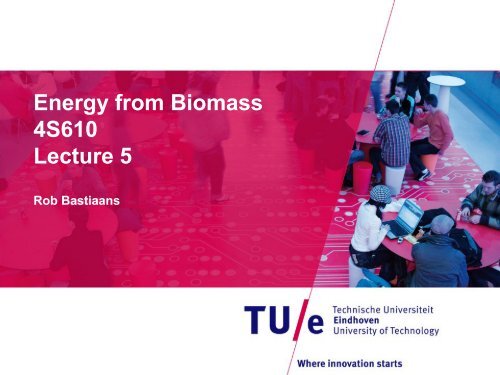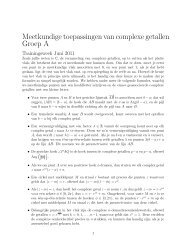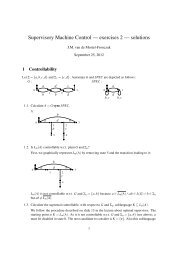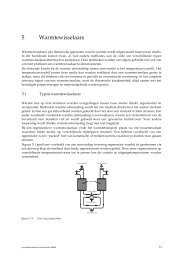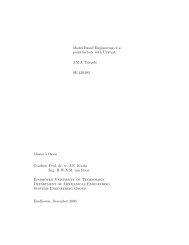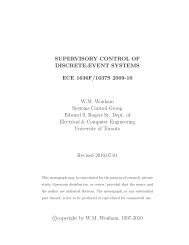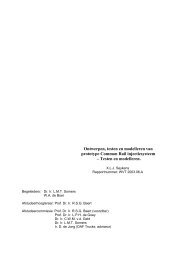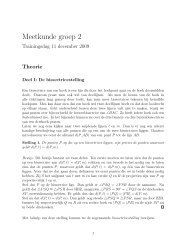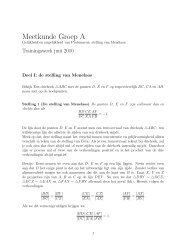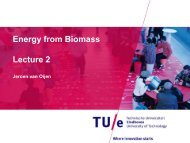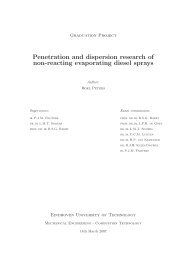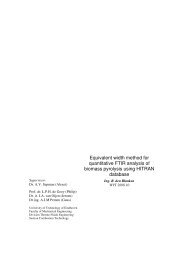Lecture 5 - Mechanical Engineering
Lecture 5 - Mechanical Engineering
Lecture 5 - Mechanical Engineering
You also want an ePaper? Increase the reach of your titles
YUMPU automatically turns print PDFs into web optimized ePapers that Google loves.
Energy from Biomass<br />
4S610<br />
<strong>Lecture</strong> 5<br />
Rob Bastiaans
Contents this lecture: Particles<br />
• Different modes of conversion<br />
• Time scale of particle conversion<br />
• Dependence on physics<br />
• Drying<br />
• Gasification<br />
• Combustion<br />
• Based on equations of lecture 4<br />
• Simplifications<br />
/ <strong>Mechanical</strong> <strong>Engineering</strong><br />
29-11-2012 PAGE 1
Energy from biomass<br />
Course outline<br />
1.Biomass macro systems<br />
2.Biomass micro systems<br />
3.Practical work<br />
/ <strong>Mechanical</strong> <strong>Engineering</strong><br />
29-11-2012 PAGE 2
Summary previous lecture<br />
Basic equations<br />
• Conservation<br />
• Peculiarities of species conversion<br />
• Simplifications<br />
• Steady<br />
• One-dimensional<br />
• Model flow reactors PSR, PFR<br />
• Important: no model gives you exact answers!<br />
• Still much research<br />
• You always have to think<br />
/ <strong>Mechanical</strong> <strong>Engineering</strong><br />
29-11-2012 PAGE 3
Particle conversion: what happens<br />
• Heating up and drying by convection/radiation<br />
• Evaporation and pyrolysis<br />
• Volatile products: water vapour, hydrocarbons,<br />
carbon oxides, H, S and N compounds, residual<br />
char<br />
• Mixing/diffusion of ambient oxidizer with<br />
combustibles<br />
• Ignition, needs high temperature<br />
• Combustion of volatiles (homogeneous reaction)<br />
• Combustion of residual char (heterogeneous<br />
reaction)<br />
/ <strong>Mechanical</strong> <strong>Engineering</strong> 29-11-2012 PAGE 4
Time scales and temperatures for<br />
pulverized fuel<br />
• Input fuel particles of 10-100 m<br />
• Preheating: 200 – 300 o C, < 1 ms<br />
• Pyrolysis: 300 – 1000 o C, 1-10 ms<br />
• Combustion of volatile matter: 1200 – 1500 o C, 5 -<br />
50 ms<br />
• Char burnout: 1500 – 2000 o C, 50 - 5000 ms<br />
• Particles fall apart<br />
• Resulting fly ash, 0.1 – 50 m, coagulation,<br />
sintering<br />
/ <strong>Mechanical</strong> <strong>Engineering</strong> 29-11-2012 5
Particle heating in different reactors<br />
• Pulverized fuel (entrained flow reactor): mixing of<br />
hot flue gas in near burner zone<br />
• Fluidized bed: heat transferred by particles (sand)<br />
• Grate furnaces: radiation important heat transfer<br />
• Fixed bed: convection, conduction and internal<br />
radiation<br />
/ <strong>Mechanical</strong> <strong>Engineering</strong> 29-11-2012 6
Partial processes of coal combustion in<br />
firing systems<br />
/ <strong>Mechanical</strong> <strong>Engineering</strong> 29-11-2012 7
Pulverized fuel combustion<br />
8 / <strong>Mechanical</strong> <strong>Engineering</strong><br />
29-11-2012
Particle conversion: mechanical integrity<br />
/ <strong>Mechanical</strong> <strong>Engineering</strong> 29-11-2012 9
Modeling conversion of spherical<br />
particles<br />
a. Liquid particles<br />
b. Solid particles<br />
• Quiescent medium (for validation of<br />
models g is used)<br />
• Laminar flow<br />
• Turbulent flow<br />
/ <strong>Mechanical</strong> <strong>Engineering</strong><br />
29-11-2012 PAGE 10
Modes of particle combustion<br />
/ <strong>Mechanical</strong> <strong>Engineering</strong> 29-11-2012 11
Modes of particle conversion<br />
• Shrinking sphere: particle surface combustion,<br />
products leave particle as they are produced<br />
• Shrinking core: combustion on a reaction core,<br />
with build up of an ash/char layer<br />
• Shrinking density: uniform combustion inside the<br />
particle, conserved particle size, decrease of<br />
density<br />
/ <strong>Mechanical</strong> <strong>Engineering</strong> 29-11-2012 12
Conversion rate<br />
(log –scale)<br />
Process regimes: Arrhenius plot<br />
Boundary<br />
Layer<br />
Diffusion<br />
Pore diffusion<br />
Chemical reaction<br />
High T<br />
High<br />
reaction<br />
rate<br />
Low T, limits<br />
Conversion rate<br />
III II I<br />
1/T<br />
/ <strong>Mechanical</strong> <strong>Engineering</strong> 29-11-2012 13
I Shrinking density particle combustion<br />
• Determine dimensionless numbers<br />
• Find correct regimes of combustion<br />
• Mass transfer to particle versus diffusion in the<br />
particle (Biot number)<br />
• Chars give Bi < 4 → high external resistance to<br />
oxidizer diffusion into the particle<br />
• Reaction controlled by internal diffusion or<br />
reaction rate (Thiele number)<br />
• Low Thiele numbers -> low reaction rates -><br />
reaction controlled -> shrinking density valid<br />
/ <strong>Mechanical</strong> <strong>Engineering</strong> 29-11-2012 14
Porous particle:<br />
• Diffusion coefficient<br />
‣ Outside particle:<br />
‣ Inside particle:<br />
Deff D Ox<br />
D<br />
eff<br />
<br />
<br />
2<br />
D<br />
Ox<br />
• Steady state<br />
• One step conversion of carbon to carbon<br />
dioxide: equimolar, no gas flow<br />
/ <strong>Mechanical</strong> <strong>Engineering</strong> 29-11-2012 15
Particle conversion<br />
Looking at oxygen concentration:<br />
1 <br />
t r r<br />
2<br />
( YOx<br />
) ( r uY<br />
)<br />
2<br />
Ox<br />
<br />
1<br />
<br />
Y<br />
r D S<br />
2<br />
Ox<br />
( )<br />
2<br />
eff<br />
r r r<br />
/ <strong>Mechanical</strong> <strong>Engineering</strong> 29-11-2012 16
Particle conversion<br />
What would be the equation for the carbon<br />
/ <strong>Mechanical</strong> <strong>Engineering</strong> 29-11-2012 17
Particle conversion<br />
Equimolar conditions, no flow<br />
What about density<br />
/ <strong>Mechanical</strong> <strong>Engineering</strong> 29-11-2012 18
Particle conversion<br />
Result:<br />
1 Y<br />
r D S<br />
r r r<br />
2<br />
Ox<br />
0 ( )<br />
2<br />
eff<br />
Inside particle:<br />
S k Y<br />
Ox<br />
Ox<br />
Dimensionless coordinate<br />
and fraction:<br />
r/ Rp<br />
Y<br />
Ox<br />
/ Y<br />
Ox,<br />
<br />
/ <strong>Mechanical</strong> <strong>Engineering</strong> 29-11-2012 19
Particle conversion<br />
• Results in the equation:<br />
• With the Thiele modulus:<br />
1 <br />
0 ( ) Th<br />
<br />
2 2<br />
2<br />
<br />
Th Rp kOx / Deff<br />
• Th>>1 conversion controlled by diffusion<br />
• Th
Boundary conditions<br />
• Boundary condition at centre<br />
• At the surface:<br />
<br />
<br />
<br />
0<br />
YOx<br />
Deff ( YOx YOx<br />
, )<br />
r<br />
• With beta a mass transfer coefficient<br />
/ <strong>Mechanical</strong> <strong>Engineering</strong> 29-11-2012 21
Solution<br />
• This yields:<br />
• With A, B:<br />
1<br />
Aexp( Th ) Bexp( Th<br />
)<br />
<br />
<br />
A<br />
B<br />
<br />
Bim<br />
( Bi Th 1)exp( Th) ( Th 1 Bi )exp( Th)<br />
m<br />
m<br />
• And Biot number<br />
Bi R / D<br />
m p eff<br />
/ <strong>Mechanical</strong> <strong>Engineering</strong> 29-11-2012 22
Solution: Bi<br />
Bi R / D<br />
m p eff<br />
Bi>>1 pore diffusion limited<br />
Bi=1 limited boundary layer transport<br />
/ <strong>Mechanical</strong> <strong>Engineering</strong> 29-11-2012 23
Solution: Th<br />
Th R k /<br />
p<br />
Ox<br />
D<br />
eff<br />
Th>>1 diffusion controlled (front)<br />
Th
Evaluation<br />
• Porosity not constant<br />
• Function of t<br />
• Therefore also function of r<br />
• Change in gas-density<br />
• Temporal effects<br />
• When is the stationary solution relevant<br />
• Temporal simulations can be done (validate latter)<br />
• Valid for shrinking sphere as well<br />
• Change position of boundary condition as function of<br />
depletion of the boundary<br />
/ <strong>Mechanical</strong> <strong>Engineering</strong> 29-11-2012 25
Summary<br />
• Typical time scales and particle sizes<br />
• Arrhenius plot<br />
• Typical conversion modes<br />
• Shrinking core<br />
• Shrinking sphere<br />
• Shrinking density<br />
• Understanding present model and assumptions<br />
• Meaning of dimensionless numbers and what<br />
happens for a certain combination<br />
• Thiele<br />
• Biot<br />
/ <strong>Mechanical</strong> <strong>Engineering</strong> 29-11-2012 26
Break<br />
/ <strong>Mechanical</strong> <strong>Engineering</strong><br />
29-11-2012 PAGE 27
II Shrinking sphere model for liquid<br />
particle combustion<br />
flamefront<br />
T<br />
Y Ox<br />
droplet<br />
Y F<br />
r d<br />
r f<br />
/ <strong>Mechanical</strong> <strong>Engineering</strong> 29-11-2012 28
<strong>Mechanical</strong> <strong>Engineering</strong> 29-11-2012 29
Combustion of liquid particles:<br />
Spalding model (1953)<br />
• Spherical symmetry<br />
• Isolated droplet in infinite medium<br />
• Isobaric process<br />
• Infinitely fast chemical reaction (vs. diffusion)<br />
• Constant gas phase transport properties and c p<br />
• Gas phase quasi-steadiness<br />
• Constant, uniform droplet temperature (no droplet<br />
heating)<br />
• No radiation, Soret, Dufour effects<br />
• Unity Lewis numbers for all gaseous species<br />
• No buoyancy<br />
vD<br />
/ c p<br />
/ <strong>Mechanical</strong> <strong>Engineering</strong> 29-11-2012 30
General form for different processes<br />
• Evaporation of liquid droplets<br />
• Burning of liquid droplets<br />
• One film model for burning of solid particles<br />
• Two film model for burning of solid particles<br />
/ <strong>Mechanical</strong> <strong>Engineering</strong> 29-11-2012 31
Droplet evaporation (shrinking sphere)<br />
T<br />
<br />
<br />
T b<br />
T d<br />
Heat up time neglected!<br />
/ <strong>Mechanical</strong> <strong>Engineering</strong> 29-11-2012 32
Evaporation time<br />
• Determined by<br />
dm d<br />
dt<br />
m<br />
• With the initial droplet mass<br />
• Giving:<br />
md<br />
<br />
1 D 6<br />
3<br />
dD<br />
dt<br />
3<br />
<br />
<br />
6<br />
m<br />
<br />
dD<br />
dt<br />
<br />
2<br />
D<br />
2<br />
m<br />
/ <strong>Mechanical</strong> <strong>Engineering</strong> 29-11-2012 33
Evaporation time:D square law<br />
• Or<br />
dD<br />
dt<br />
2<br />
<br />
<br />
4<br />
D<br />
m<br />
K<br />
• With K the evaporation constant, integrating:<br />
• Giving:<br />
D<br />
<br />
<br />
D<br />
2<br />
2<br />
0<br />
dD<br />
2<br />
t<br />
0<br />
Kdt<br />
D<br />
2<br />
( t)<br />
D<br />
2 0<br />
<br />
Kt<br />
/ <strong>Mechanical</strong> <strong>Engineering</strong> 29-11-2012 34
Droplet evaporation<br />
/ <strong>Mechanical</strong> <strong>Engineering</strong> 29-11-2012 35
What is K, the mass conversion rate<br />
• Continuity (outside particle)<br />
m<br />
<br />
v4r<br />
2<br />
<br />
C<br />
• Energy:<br />
d dT d<br />
<br />
Lec dr dr dr<br />
p<br />
2 2<br />
r r vT<br />
<br />
<br />
/ <strong>Mechanical</strong> <strong>Engineering</strong> 29-11-2012 36
Solution strategy<br />
• Integrate the energy equation twice<br />
• Find integration constants with B.C.’s:<br />
• T(r=r s )=T boil<br />
• T(r->)=T <br />
• Now T(r) is known<br />
• Use a heat balance at the droplet surface:<br />
4r<br />
2<br />
s<br />
dT<br />
dr<br />
r<br />
s<br />
m h<br />
evap<br />
/ <strong>Mechanical</strong> <strong>Engineering</strong> 29-11-2012 37
What is K<br />
• After some math:<br />
4r<br />
8<br />
m ln( Bq<br />
1)<br />
K ln( Bq<br />
1)<br />
c<br />
cp<br />
p<br />
• With Spalding number for evaporation:<br />
B<br />
q<br />
<br />
c<br />
p<br />
<br />
T<br />
<br />
h<br />
T<br />
evap<br />
b<br />
<br />
/ <strong>Mechanical</strong> <strong>Engineering</strong> 29-11-2012 38
Droplet evaporation<br />
/ <strong>Mechanical</strong> <strong>Engineering</strong> 29-11-2012 39
Droplet evaporation: exercise<br />
• Consider a 500 m diameter droplet of n-hexane<br />
(C 6 H 14 ), evaporating in hot (850 K) nitrogen. The<br />
boiling point is 342 K.<br />
• What is the lifetime<br />
• Try this at home…<br />
/ <strong>Mechanical</strong> <strong>Engineering</strong> 29-11-2012 40
Droplet burning: Temperature profile<br />
/ <strong>Mechanical</strong> <strong>Engineering</strong> 29-11-2012 41
Droplet burning: species profiles<br />
/ <strong>Mechanical</strong> <strong>Engineering</strong> 29-11-2012 42
Spalding transfer number fot liquid<br />
droplet combustion<br />
• Relative energy excess scaled with heat of<br />
vaporization<br />
B<br />
0, q<br />
<br />
h<br />
comb<br />
/ <br />
h<br />
c<br />
p<br />
evap<br />
<br />
T<br />
<br />
T<br />
b<br />
<br />
• Typical for combustion of liquid fuels in air, B=1 - 10<br />
/ <strong>Mechanical</strong> <strong>Engineering</strong> 29-11-2012 43
Important results<br />
• Burn out time, d-square –law<br />
2<br />
t D /<br />
0<br />
K<br />
• Flame front distance<br />
• Flame temperature<br />
T<br />
f<br />
<br />
T<br />
b<br />
r<br />
r<br />
f<br />
s<br />
<br />
<br />
c<br />
h<br />
p<br />
<br />
<br />
<br />
<br />
ln 1<br />
B0,<br />
q<br />
ln 1 /<br />
<br />
evap<br />
B<br />
1<br />
0,<br />
q<br />
<br />
1<br />
/ <strong>Mechanical</strong> <strong>Engineering</strong> 29-11-2012 44
Droplet burning<br />
/ <strong>Mechanical</strong> <strong>Engineering</strong> 29-11-2012 45
Droplet burning experiments<br />
/ <strong>Mechanical</strong> <strong>Engineering</strong> 29-11-2012 46
Droplet combustion: exercise<br />
• Consider a 100 m diameter droplet of n-heptane<br />
(C 7 H 16 ), combusting at atmospheric pressure and<br />
at T=300 K<br />
• What is the mass burning rate<br />
• Flame temperature<br />
• Stand-off distance relative to the droplet radius<br />
/ <strong>Mechanical</strong> <strong>Engineering</strong> 29-11-2012 47
Evaluation<br />
• Constant burning rate, flame stand off distance<br />
and flame temperature<br />
• Single component droplets: good qualitative<br />
agreement<br />
• Quantitative agreement by tuning<br />
• Flame stand off ratio: over-predicted (difficult to<br />
tune)<br />
• Solid particles exhibit a d 2 -law as well<br />
• Conclusion: some errors, improvements over the<br />
years, but still frequently used<br />
/ <strong>Mechanical</strong> <strong>Engineering</strong> 29-11-2012 48
Spalding transfer number for solid<br />
particle combustion<br />
• Surface burning:<br />
B ....<br />
• Off-surface burning (two film)<br />
B ....<br />
/ <strong>Mechanical</strong> <strong>Engineering</strong> 29-11-2012 49
Modes of particle evaporation &<br />
combustion<br />
• Shrinking density: uniform combustion inside the<br />
particle, conserved particle size, decrease of<br />
density Thiele modulus (Th), Biot number (Bi m )<br />
• Shrinking sphere: particle surface combustion,<br />
ash leaves particle as it is produced Spalding<br />
transfer number (B)<br />
• Shrinking core: combustion on a reaction core,<br />
with build up of an ash layer Solid particles<br />
/ <strong>Mechanical</strong> <strong>Engineering</strong> 29-11-2012 50
Application in turbulent systems<br />
/ <strong>Mechanical</strong> <strong>Engineering</strong> 29-11-2012 51
Application in turbulent systems: factors<br />
• Particle density important<br />
• Ratio of inter-particle spacing/flame standoff<br />
distance<br />
• Single particle burning – group burning<br />
• Length scale ratio of turbulent eddies and single<br />
particles/groups<br />
• Standard CFD uses some correlations on basis of<br />
Spalding transfer number<br />
/ <strong>Mechanical</strong> <strong>Engineering</strong> 29-11-2012 52
Application in turbulent systems<br />
/ <strong>Mechanical</strong> <strong>Engineering</strong> 29-11-2012 53
Different modes<br />
/ <strong>Mechanical</strong> <strong>Engineering</strong> 29-11-2012 54
Turbulent vaporization systems<br />
/ <strong>Mechanical</strong> <strong>Engineering</strong> 29-11-2012 55
Turbulent (group) combustion<br />
/ <strong>Mechanical</strong> <strong>Engineering</strong> 29-11-2012 56
Next lecture: Marcel Cremers of Kema<br />
and emissions<br />
/ <strong>Mechanical</strong> <strong>Engineering</strong><br />
29-11-2012 PAGE 57
Questions<br />
/ <strong>Mechanical</strong> <strong>Engineering</strong><br />
29-11-2012 PAGE 58


